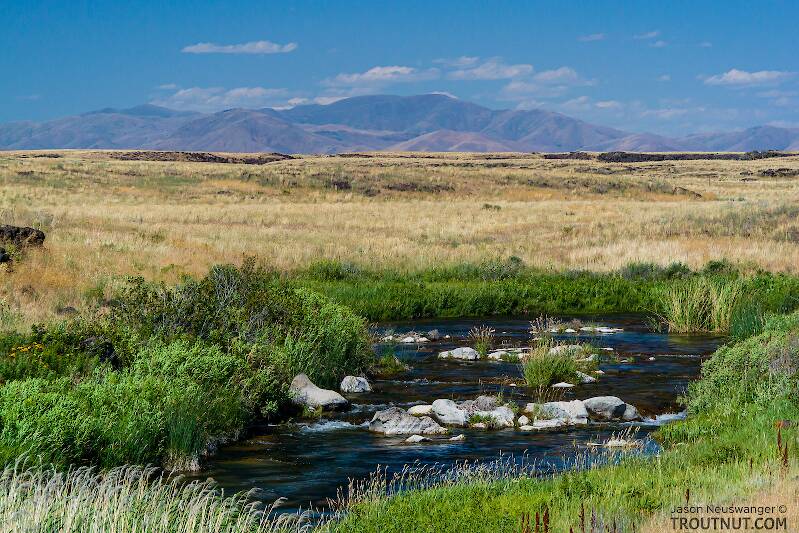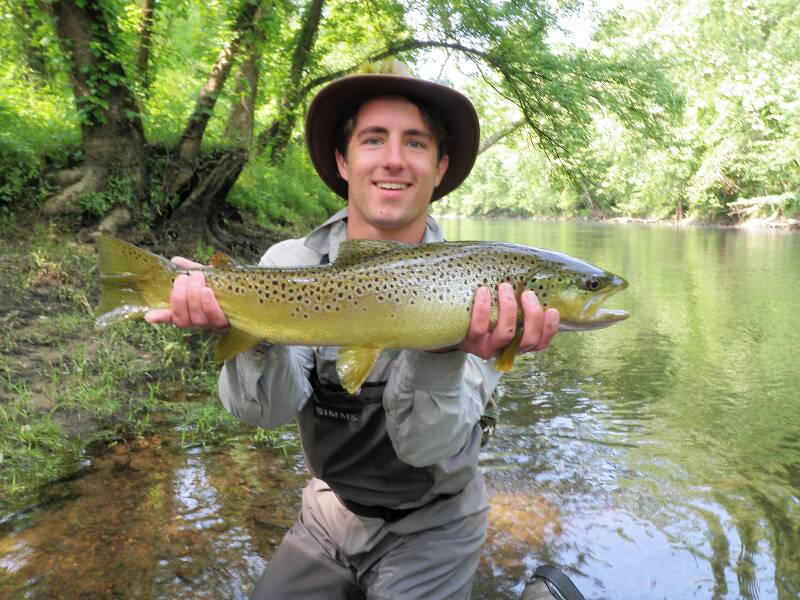
Hex Mayflies
Hexagenia limbata
The famous nocturnal Hex hatch of the Midwest (and a few other lucky locations) stirs to the surface mythically large brown trout that only touch streamers for the rest of the year.
Featured on the forum

This species was fairly abundant in a February sample of the upper Yakima.

Troutnut is a project started in 2003 by salmonid ecologist Jason "Troutnut" Neuswanger to help anglers and
fly tyers unabashedly embrace the entomological side of the sport. Learn more about Troutnut or
support the project for an enhanced experience here.
Opie610 on Dec 29, 2012December 29th, 2012, 2:59 pm EST
I have a question about emerger size vs adult size. If my favorite streams hatch chart calls for sz16 to sz18 Olive Caddis, what size emerger would i fish? Are the emergers bigger, smaller or the same size as the adult?
Thanks
Brent
Thanks
Brent
Entoman on Dec 29, 2012December 29th, 2012, 4:46 pm EST
Hi Brent -
Welcome to the Forum.
The quick answer is that there's no way to know with real certainty unless you have a good idea what the chart is using for size reference and know a few things about the species in question. Most charts are typically based on angler reports. The best you can do without capturing and comparing a few naturals is to use pupal imitations one size smaller than the recommendations and have some a size even smaller to go to if needed. With dozens of different hook styles (let alone tying styles) and a lot of misunderstanding about sizing these critters, hatch chart sizes are at best only very general recommendations. While most anglers would agree it best to match the size of the critters we imitate as precisely as we can whenever possible, it's also true that it's better to error on the small side than the large side in most cases.
As said above, there are a plethora of hook manufacturers & styles on the market and they each have their own standards regarding size. This causes trouble enough but dealing with caddis compounds the issue. Here's why...
When caddis sizes are mentioned they usually refer to adults that are measured in angling literature the way biologists do, from head to wingtips folded over the body. Since pupae (or more accurately pharate adults) lack fully formed wings, they are measured from head to abdomen tip, which means they are usually substantially smaller than the adults in terms of overall length. The kicker is they are actually bigger bodied. Most adult caddis have bodies substantially shorter than their wings, sometimes by as much as 50%, though many have bodies that are in the 60% - 75% range of wing length. These factors cause a lot of problems for many anglers whose understanding of size is based on mayflies where adults are measured like the nymphs - from head to abdomen tip.
Practically speaking, let's assume a hatch chart used the typically tied Elkhair Caddis for reference tied on a Tiemco 100 hook with the body ending just past the hook barb and the wing extending barely past the bend (a big assumption). This would mean that a size 12 recommendation may require a size 14 to as small as an 18 pupal imitation, depending on the natural's body/wing ratio and the hook that's being used.
Welcome to the Forum.
The quick answer is that there's no way to know with real certainty unless you have a good idea what the chart is using for size reference and know a few things about the species in question. Most charts are typically based on angler reports. The best you can do without capturing and comparing a few naturals is to use pupal imitations one size smaller than the recommendations and have some a size even smaller to go to if needed. With dozens of different hook styles (let alone tying styles) and a lot of misunderstanding about sizing these critters, hatch chart sizes are at best only very general recommendations. While most anglers would agree it best to match the size of the critters we imitate as precisely as we can whenever possible, it's also true that it's better to error on the small side than the large side in most cases.
As said above, there are a plethora of hook manufacturers & styles on the market and they each have their own standards regarding size. This causes trouble enough but dealing with caddis compounds the issue. Here's why...
When caddis sizes are mentioned they usually refer to adults that are measured in angling literature the way biologists do, from head to wingtips folded over the body. Since pupae (or more accurately pharate adults) lack fully formed wings, they are measured from head to abdomen tip, which means they are usually substantially smaller than the adults in terms of overall length. The kicker is they are actually bigger bodied. Most adult caddis have bodies substantially shorter than their wings, sometimes by as much as 50%, though many have bodies that are in the 60% - 75% range of wing length. These factors cause a lot of problems for many anglers whose understanding of size is based on mayflies where adults are measured like the nymphs - from head to abdomen tip.
Practically speaking, let's assume a hatch chart used the typically tied Elkhair Caddis for reference tied on a Tiemco 100 hook with the body ending just past the hook barb and the wing extending barely past the bend (a big assumption). This would mean that a size 12 recommendation may require a size 14 to as small as an 18 pupal imitation, depending on the natural's body/wing ratio and the hook that's being used.
"It's not that I find fishing so important, it's just that I find all other endeavors of Man equally unimportant... And not nearly as much fun!" Robert Traver, Anatomy of a Fisherman
Martinlf on Dec 31, 2012December 31st, 2012, 8:01 am EST
Kurt gives a very thorough and accurate answer. As an addendum, I'd say if you are using an adult tied on a 16 or 18 Tiemco 100, you could use an emerger tied on a Tiemco 2487 or 2488 in the same sizes as these hooks are a bit shorter than the 100.
Is that Berks county PA? If you're fishing the Tully, go even smaller, size 20 or 22, for both adults and emergers.
Is that Berks county PA? If you're fishing the Tully, go even smaller, size 20 or 22, for both adults and emergers.
"He spread them a yard and a half. 'And every one that got away is this big.'"
--Fred Chappell
--Fred Chappell
Opie610 on Dec 31, 2012December 31st, 2012, 2:34 pm EST
Thanks for your help guys. Have a Happy New Year!!!!
Jesse on Jan 1, 2013January 1st, 2013, 3:51 pm EST
Woah there man lets simplify that answer just a tad. Tie a couple emergers in a 14, a couple in a 16, and BOOM! Your on trout like there was never even a doubt. For most any hatch that i have ever fished when using emergers, those two sizes have done the job. Even on various caddis hatches.
Most of us fish our whole lives..not knowing its not the fish that we are after.
http://www.filingoflyfishing.com
http://www.filingoflyfishing.com
Wbranch on Jan 7, 2013January 7th, 2013, 8:51 am EST
Kurt wrote;
"Most adult caddis have bodies substantially shorter than their wings, sometimes by as much as 50%,"
This comment is spot-on! If you were to just look at a caddis in flight, or perhaps catch it but not turn it over, you might say "well the wings look like a #14" but if you turn the bug over and look at the abdomen you will instantly see that it is far shorter than the wings. In an adult dry fly I don't know if the abdomen length is critical but in the pupal form, where the wings are parallel to the body it would be important. If the pupa you tied, based on the wing length of the adult, is on a #14 hook it may be passed over by the feeding trout as they are looking for that short shank #16 hook like a TMC 2457 or 2487.
"Most adult caddis have bodies substantially shorter than their wings, sometimes by as much as 50%,"
This comment is spot-on! If you were to just look at a caddis in flight, or perhaps catch it but not turn it over, you might say "well the wings look like a #14" but if you turn the bug over and look at the abdomen you will instantly see that it is far shorter than the wings. In an adult dry fly I don't know if the abdomen length is critical but in the pupal form, where the wings are parallel to the body it would be important. If the pupa you tied, based on the wing length of the adult, is on a #14 hook it may be passed over by the feeding trout as they are looking for that short shank #16 hook like a TMC 2457 or 2487.
Catskill fly fisher for fifty-five years.
Martinlf on Jan 8, 2013January 8th, 2013, 2:44 pm EST
Good point, Matt. I do tie my emergers a bit short. ;>
"He spread them a yard and a half. 'And every one that got away is this big.'"
--Fred Chappell
--Fred Chappell
Quick Reply
Related Discussions
Topic
Replies
Last Reply
0
May 6, 2011
by Jtberez
by Jtberez
13
Jun 13, 2012
by Brookyman
by Brookyman
0
Jan 27, 2017
by Mcflyangler
by Mcflyangler





